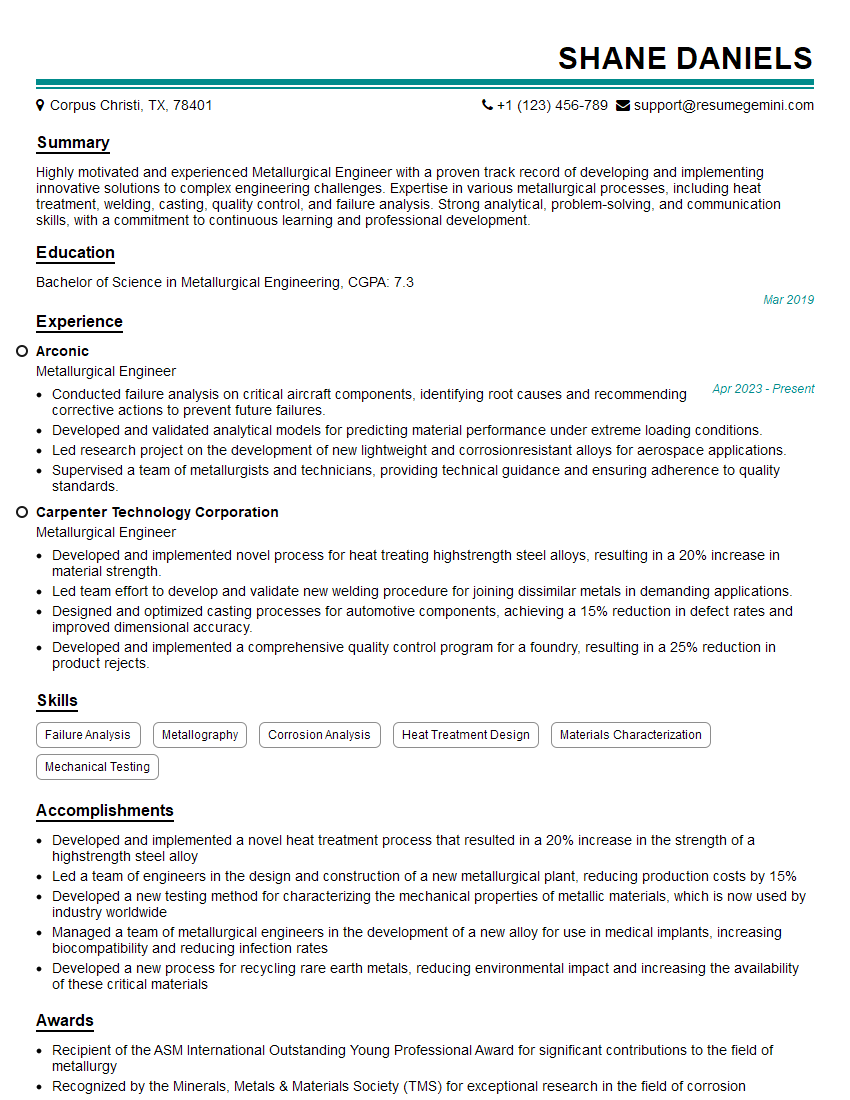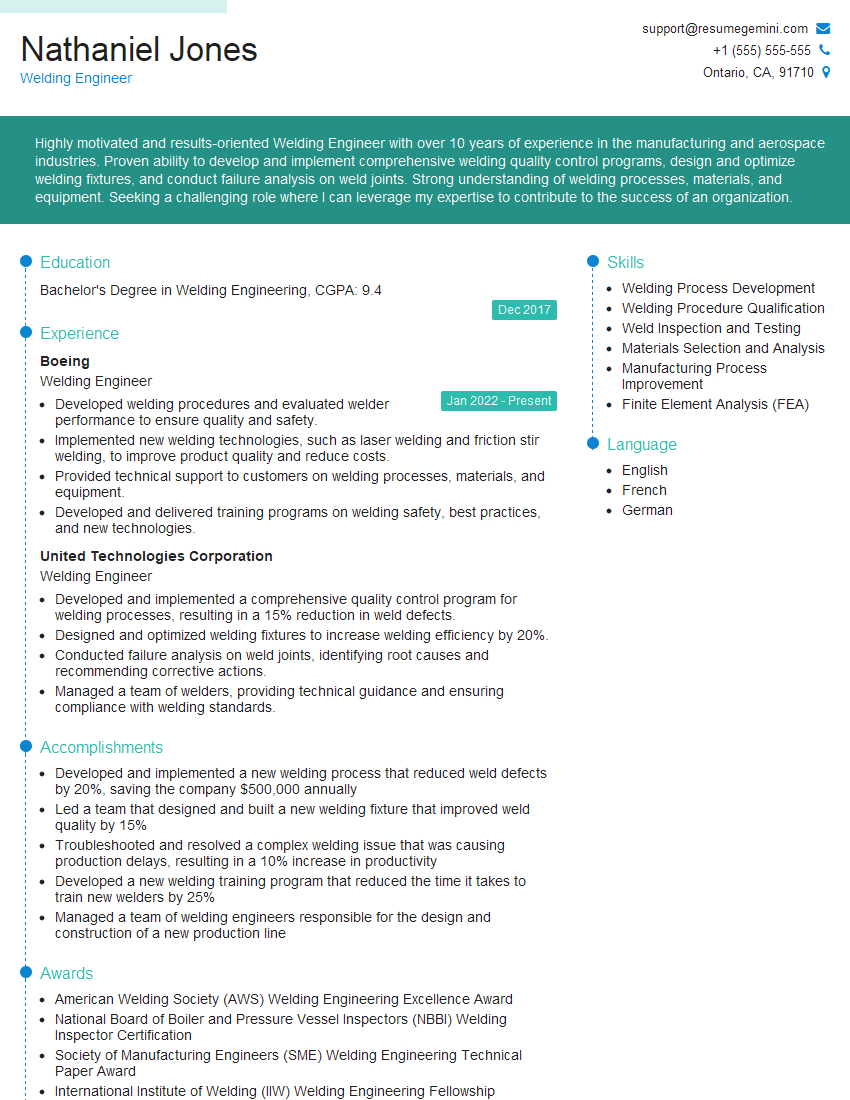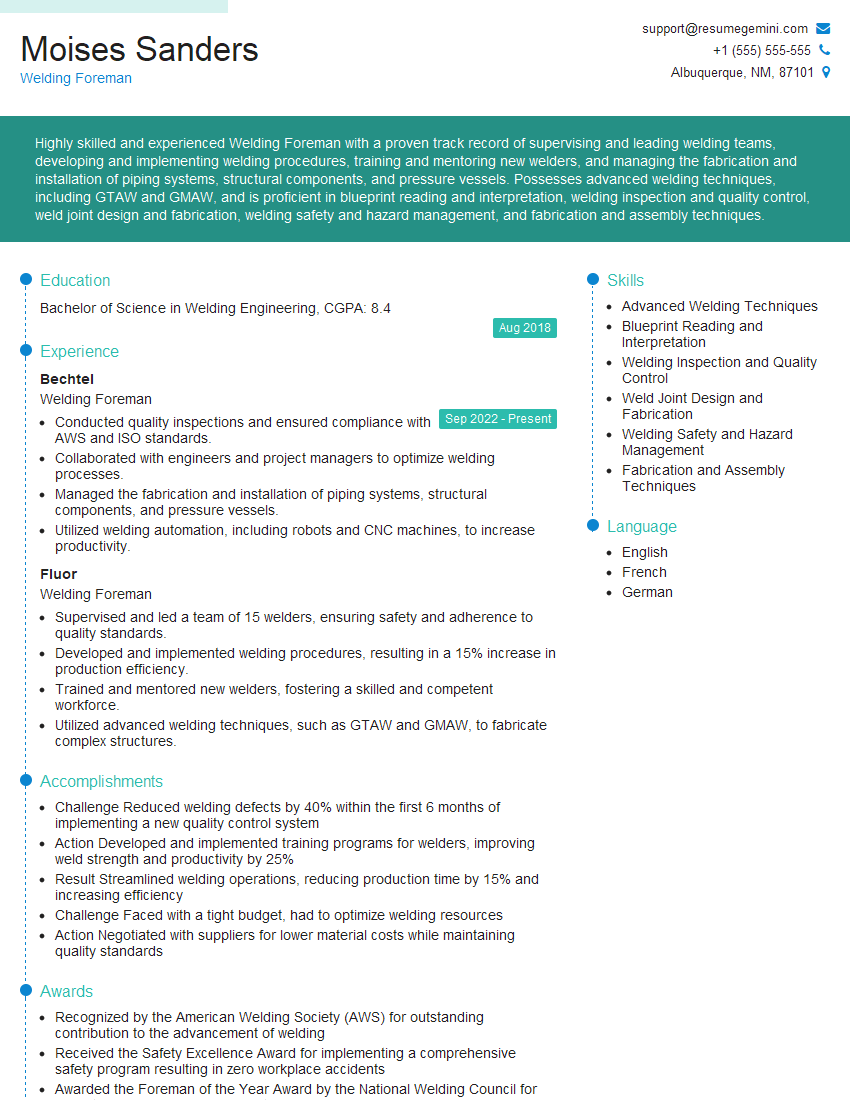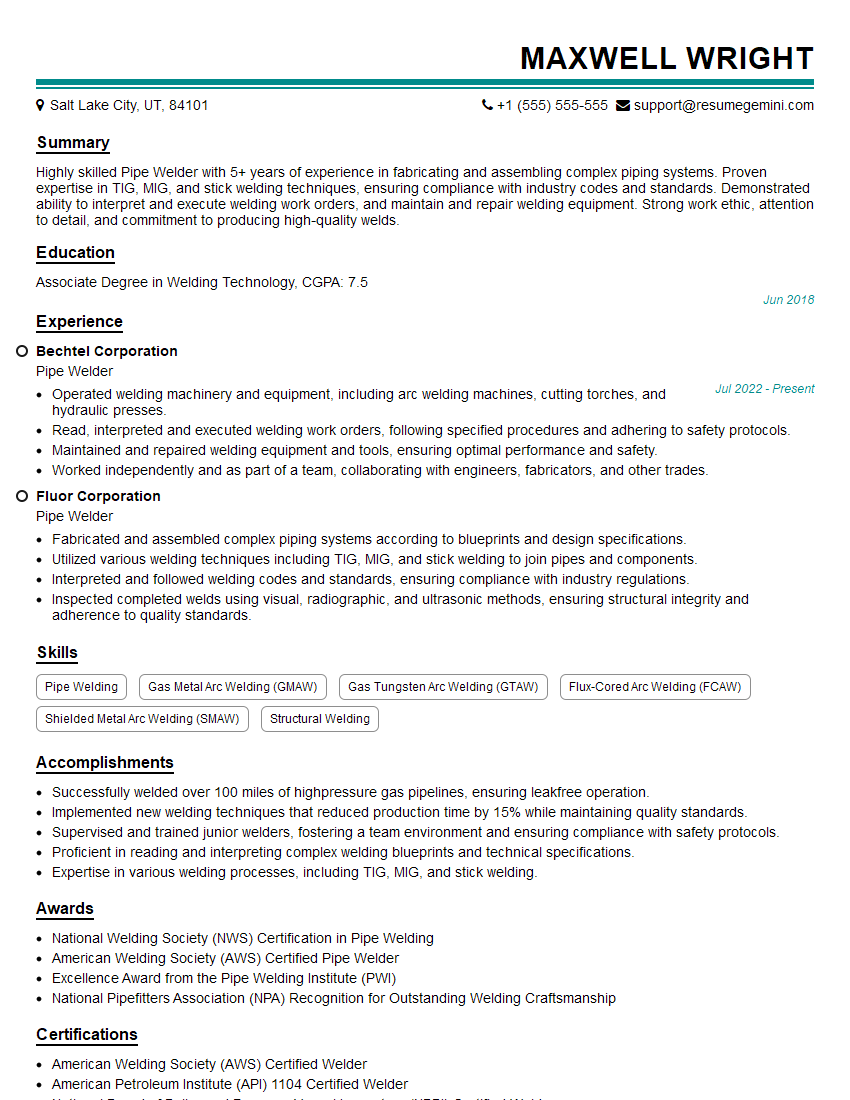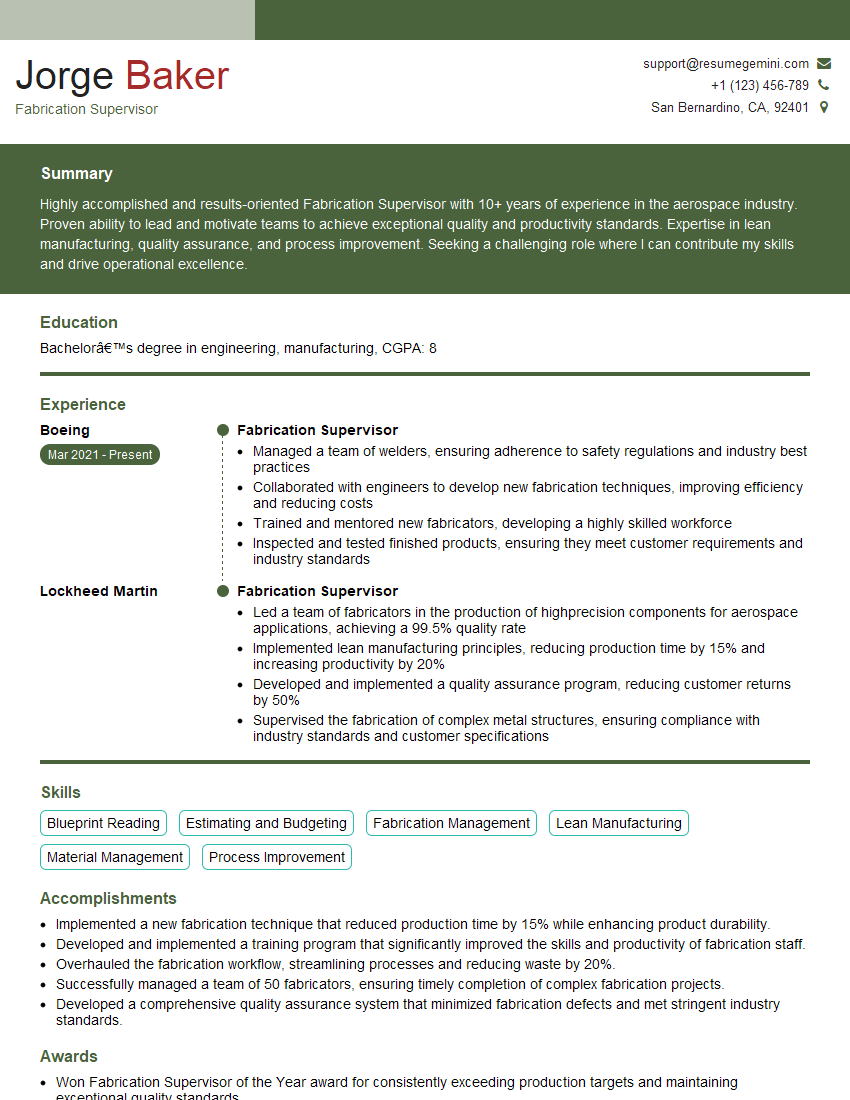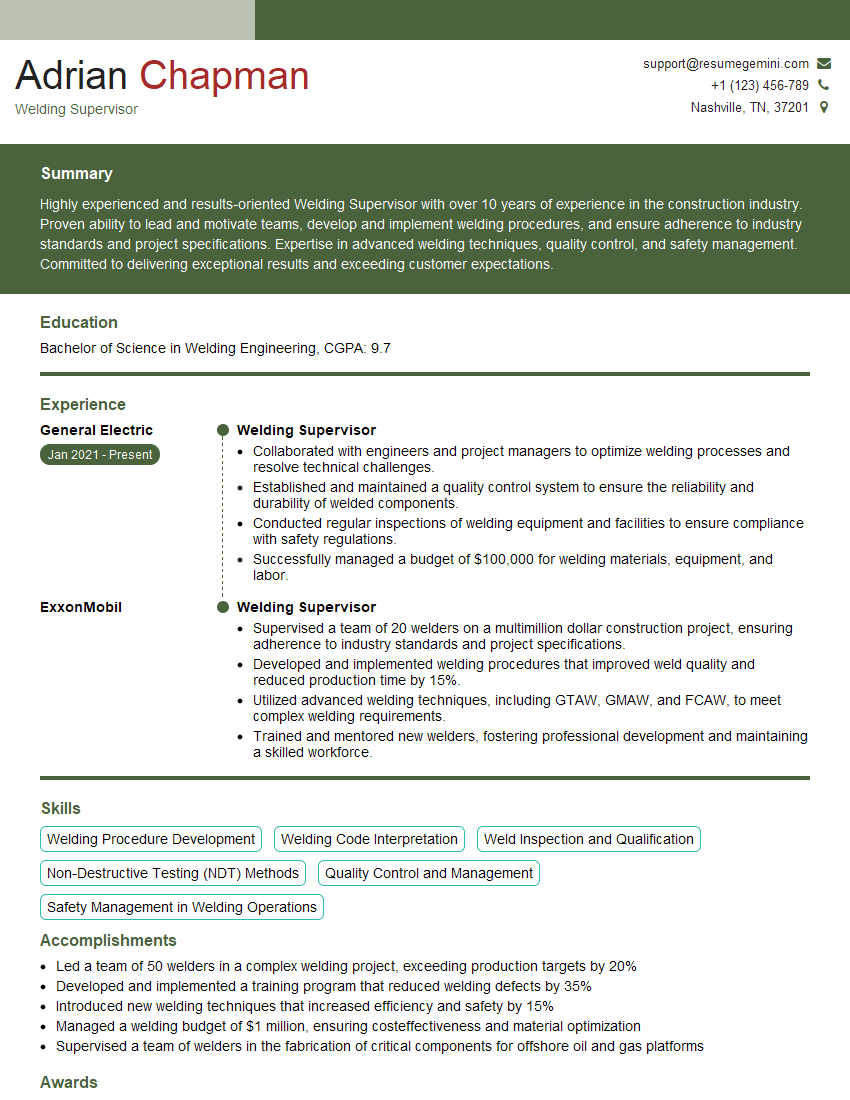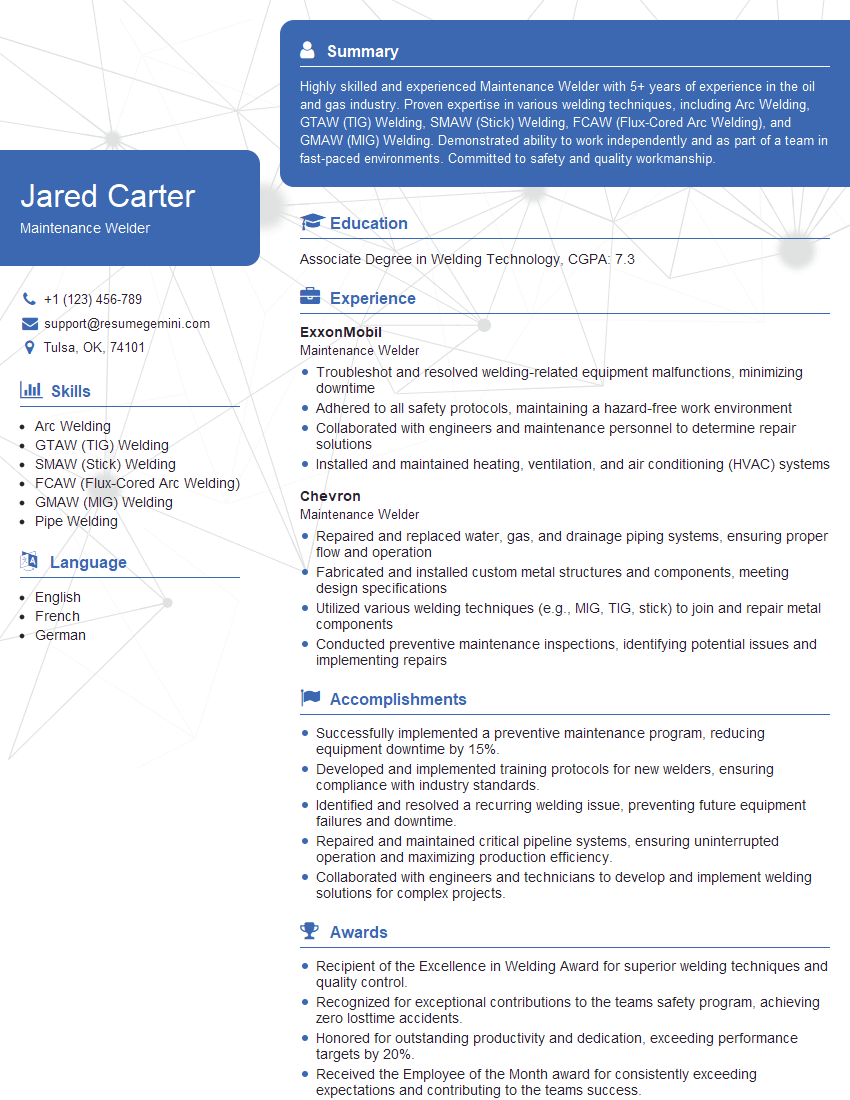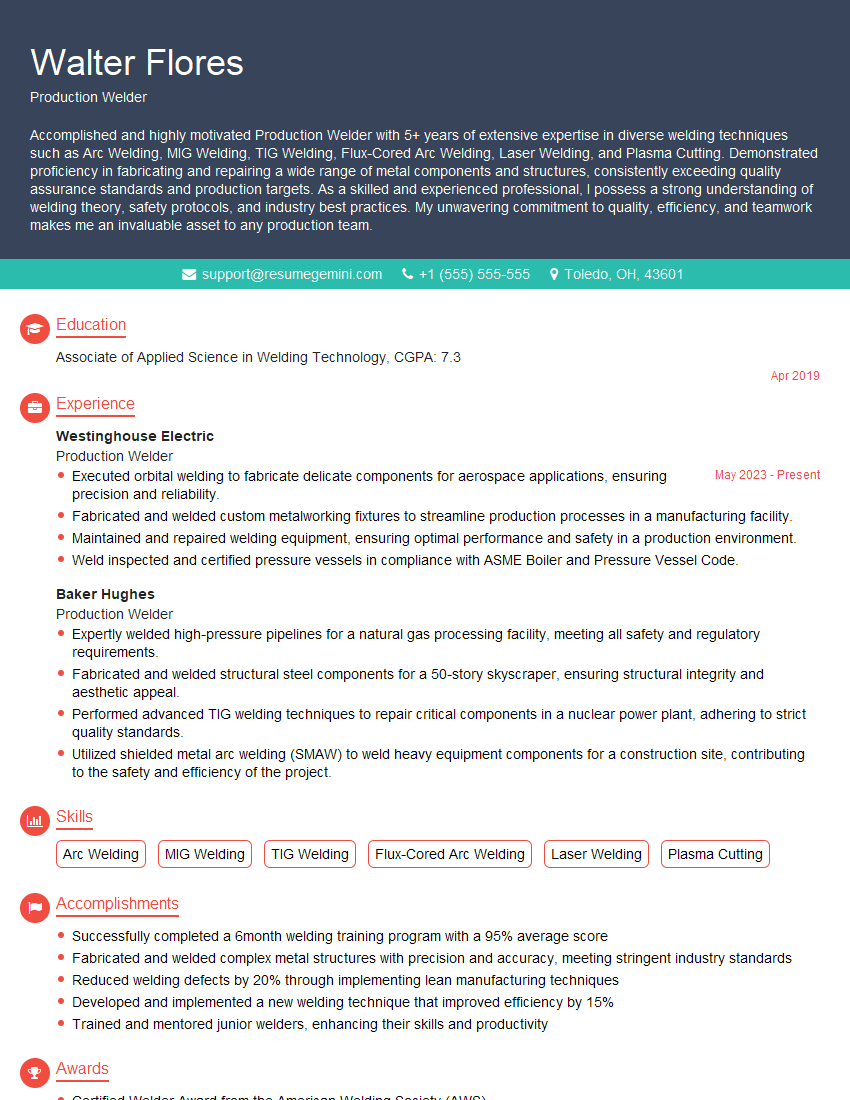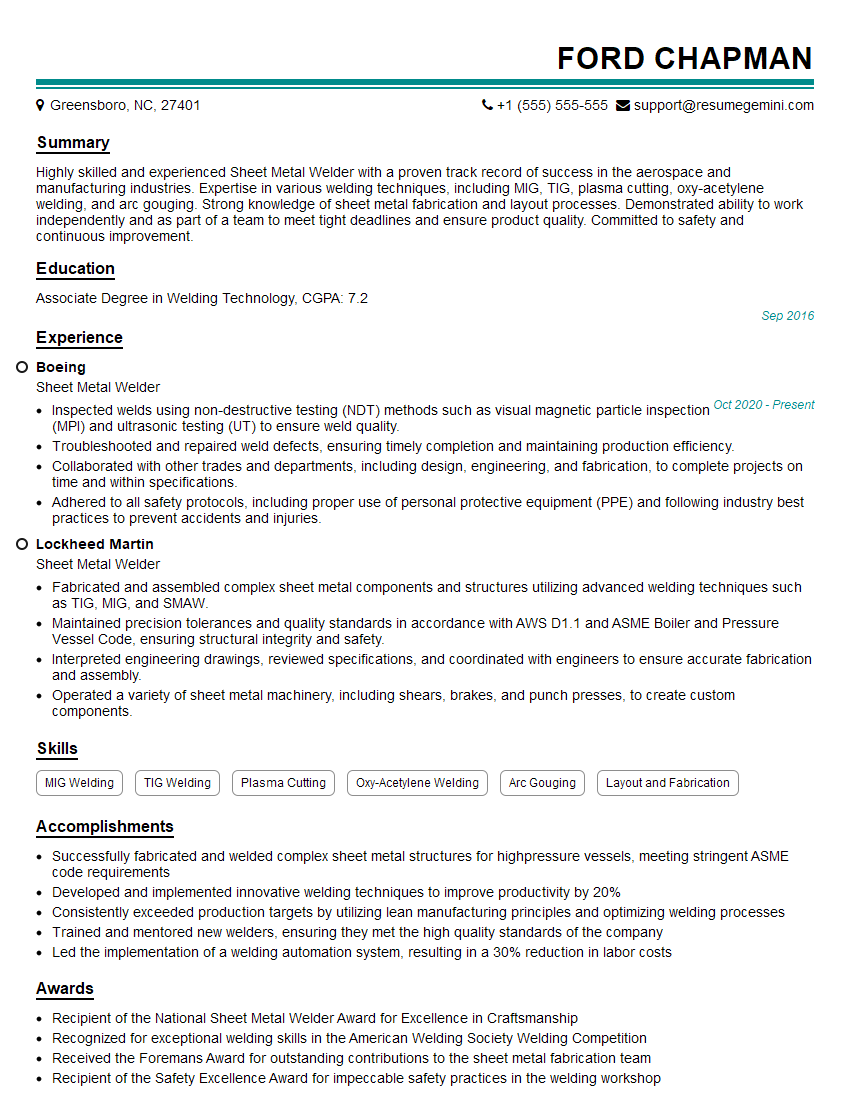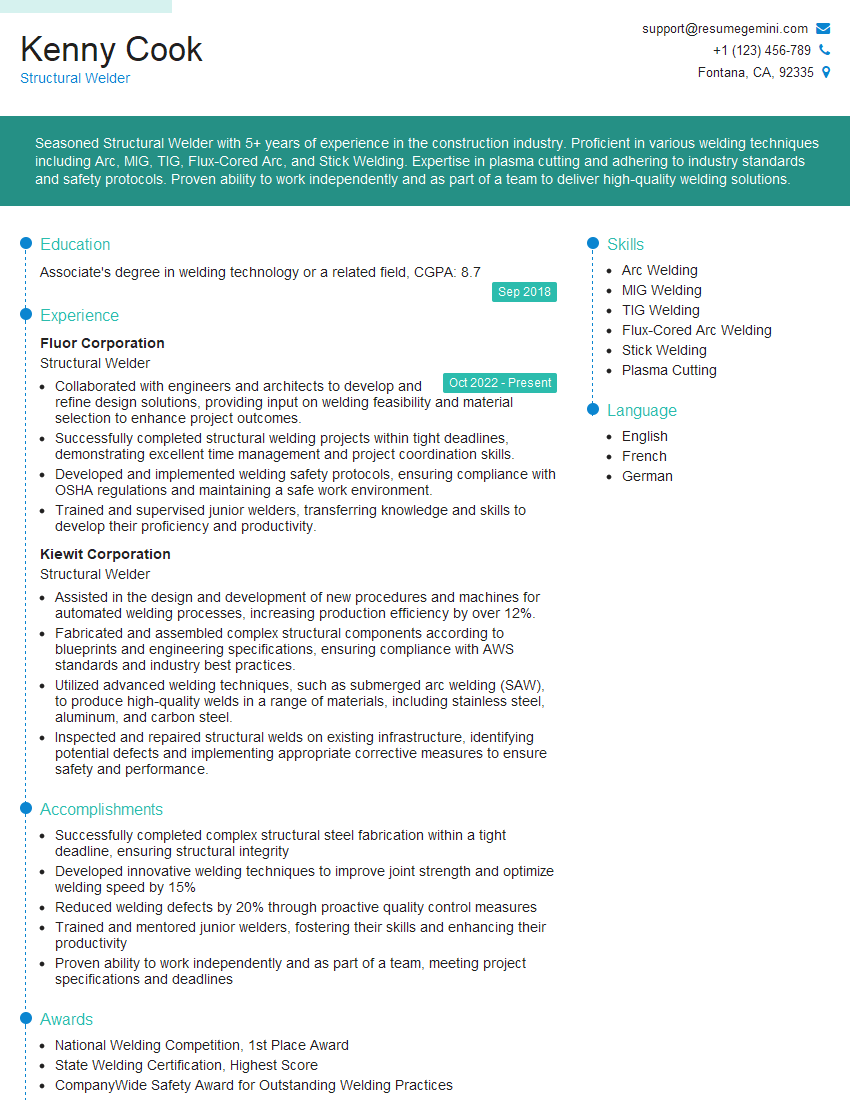The thought of an interview can be nerve-wracking, but the right preparation can make all the difference. Explore this comprehensive guide to Butt Joint Welding interview questions and gain the confidence you need to showcase your abilities and secure the role.
Questions Asked in Butt Joint Welding Interview
Q 1. Explain the principles of butt joint welding.
Butt joint welding is a fundamental welding technique where two pieces of metal are joined end-to-end, creating a continuous, flush surface. The principle involves melting the edges of both pieces and fusing them together using a suitable welding process. The strength of the resulting joint depends heavily on proper fit-up, the chosen welding process, and the skill of the welder. Imagine joining two train carriages – a perfect butt joint would make them appear as one seamless unit.
Q 2. What are the different types of butt joints?
Butt joints can be categorized in several ways:
- Square Butt Joint: The simplest type, where the edges are cut square and butted together. This is common but can be challenging to achieve perfect penetration.
- Single Bevel Butt Joint: One edge is beveled to allow for better penetration and weld pool control. This is more efficient than a square butt for thicker materials.
- Double Bevel Butt Joint: Both edges are beveled, facilitating even better penetration and reducing distortion, especially useful for thick materials.
- Single J Butt Joint: One edge is shaped like a ‘J’, providing a channel for the weld, again enhancing penetration and reducing distortion. This is common in high-strength applications.
- Double J Butt Joint: Both edges are shaped like a ‘J’. Ideal for joining very thick materials and achieving a strong, uniform weld.
The choice of joint type depends largely on material thickness, required strength, and the chosen welding process.
Q 3. Describe the various welding processes suitable for butt joints.
Many welding processes are suitable for butt joints, each with its strengths and weaknesses:
- Gas Metal Arc Welding (GMAW): A versatile process commonly used for various thicknesses and materials, offering good speed and penetration. Ideal for automation.
- Gas Tungsten Arc Welding (GTAW): Provides excellent control, high-quality welds, and is often used for critical applications requiring exceptional precision. Commonly used for thin materials and those requiring high-quality finish.
- Shielded Metal Arc Welding (SMAW): A relatively inexpensive and portable process suitable for many materials and thicknesses. However, it generally produces a less aesthetically pleasing weld.
- Submerged Arc Welding (SAW): A highly productive process ideal for thick materials and large-scale projects. Offers deep penetration and high deposition rates but lacks versatility.
The optimal process selection considers factors like material type, thickness, required quality, and cost-effectiveness.
Q 4. What are the advantages and disadvantages of butt joint welding compared to other welding methods?
Advantages of Butt Joint Welding:
- Strong Joint: When properly executed, butt joints offer high strength and integrity, comparable to the base material.
- Aesthetically Pleasing: A well-executed butt joint results in a smooth, continuous surface.
- Versatile: Applicable to a wide range of materials and thicknesses.
Disadvantages of Butt Joint Welding:
- Requires Precision Fit-up: Proper edge preparation and alignment are crucial for success. Improper fit-up leads to defects.
- Can be Challenging: Achieving complete penetration, particularly in thicker materials, requires skill and experience.
- Potential for Distortion: High heat input can cause warping or distortion.
Compared to other methods like fillet welds, butt welds offer higher strength but require more precise preparation and execution. The best method always depends on the specific application needs.
Q 5. How do you ensure proper joint fit-up before welding a butt joint?
Proper joint fit-up is paramount for a successful butt weld. This involves achieving the correct alignment and gap between the two pieces being joined. This is typically accomplished by:
- Accurate Cutting and Beveling: Using precision cutting tools like plasma cutters or milling machines to achieve the desired edge profile (square, bevel, J-shaped).
- Jigs and Fixtures: Using clamping devices to hold the pieces securely in the correct position during welding.
- Tack Welding: Using small welds to temporarily secure the parts in place before the main weld is applied.
- Checking Alignment: Regularly verifying alignment with measuring tools to ensure a consistent gap throughout the joint.
Imagine trying to build a brick wall with uneven bricks – the same principle applies to butt welds. Careful preparation ensures a strong and lasting result.
Q 6. Explain the importance of preheating in butt joint welding.
Preheating is a crucial step, especially when welding thicker sections or materials prone to cracking (like high-carbon steels). Preheating reduces the temperature gradient during welding, preventing rapid cooling that can lead to residual stresses and cracking. It also improves weld penetration and reduces the risk of hydrogen cracking. The specific preheat temperature depends on the material, thickness, and welding process. It’s often specified in welding codes and procedures. Think of preheating as slowly warming the entire material before applying intense local heat during welding; this prevents thermal shock.
Q 7. What are the common welding defects found in butt joints and how can they be prevented?
Common defects in butt welds include:
- Incomplete Penetration: The weld doesn’t fully fuse the two parts. This weakens the joint and can lead to failure. Prevention: Proper joint preparation, correct welding parameters, and skillful execution are crucial.
- Undercutting: A groove melted into the base material beside the weld. This reduces the joint’s effective area. Prevention: Maintaining proper welding speed and technique, using appropriate welding parameters.
- Porosity: Small holes in the weld caused by gas entrapment. This reduces strength and can lead to leaks. Prevention: Ensuring cleanliness of the joint, proper shielding gas coverage, and appropriate welding parameters.
- Cracking: Cracks can occur due to residual stresses or hydrogen embrittlement. Prevention: Preheat the material, use appropriate filler metals, and control cooling rates.
- Lack of Fusion: A lack of bonding between the weld metal and the base metal. Prevention: Proper joint preparation, cleaning, and welding parameters.
Regularly inspecting welds using visual inspection, radiography, or ultrasonic testing is crucial for identifying and preventing such defects. Defect prevention relies heavily on proper preparation, procedure adherence, and skilled welders.
Q 8. Describe the different types of weld inspection methods for butt joints.
Inspecting butt welds is crucial to ensure structural integrity. Several methods are employed, each offering a unique perspective on the weld’s quality. These include:
- Visual Inspection: This is the first and often most important step. It involves carefully examining the weld for surface defects like cracks, porosity, undercuts, and lack of fusion. Think of it as a thorough visual check-up. A magnifying glass can be useful for closer inspection.
- Radiographic Testing (RT): RT, using X-rays or gamma rays, reveals internal flaws like porosity, inclusions, and cracks that are invisible to the naked eye. It’s like getting a detailed internal scan of the weld. This is particularly important for welds in high-stress applications.
- Ultrasonic Testing (UT): UT uses high-frequency sound waves to detect internal defects. It’s excellent for finding cracks and lack of fusion, and it’s often preferred for thicker welds because it’s quicker than RT. Think of it as using sonar to image the inside of the weld.
- Liquid Penetrant Testing (PT): PT is used to detect surface-breaking defects. A dye is applied to the weld, and after cleaning, a developer reveals any cracks or discontinuities by drawing the dye to the surface. This is like using a highlighter to mark any surface imperfections.
- Magnetic Particle Testing (MT): MT is suitable for ferromagnetic materials. Magnetic particles are applied to the weld while it’s magnetized. Defects disrupt the magnetic field, causing the particles to accumulate, revealing the flaws. This method is quick and sensitive for surface and near-surface flaws.
The choice of inspection method depends on factors like weld size, material, and the required level of quality assurance. Often, a combination of methods is used to provide comprehensive assessment.
Q 9. How do you interpret a welding procedure specification (WPS) for butt joint welding?
A Welding Procedure Specification (WPS) is a detailed document outlining the parameters for a specific welding process, including butt joints. Interpreting a WPS is critical for consistent and high-quality welds. Here’s what to look for:
- Base Materials: The WPS specifies the type and grade of materials to be welded (e.g., carbon steel, stainless steel, aluminum). Incorrect material selection can lead to weld failure.
- Welding Process: The WPS specifies the exact welding process to be used (e.g., Gas Metal Arc Welding (GMAW), Gas Tungsten Arc Welding (GTAW)). Each process has unique characteristics impacting weld quality.
- Filler Metal: The WPS indicates the type and size of filler metal (electrode or wire) to be used. The filler metal must be compatible with the base materials.
- Welding Parameters: This is the heart of the WPS. It provides crucial details about the settings to use, including:
- Current (Amperage): The amount of electrical current used.
- Voltage: The electrical potential difference.
- Travel Speed: The speed at which the welding torch is moved along the joint.
- Shielding Gas Type and Flow Rate: The type and flow rate of the protective gas (e.g., argon, helium, CO2).
- Preheating and Post-heating Temperatures: Temperatures used to prepare and cool the weld, sometimes crucial for specific materials.
- Joint Design: The WPS describes the preparation of the joint (e.g., bevel angle, root gap) to ensure proper penetration and fusion.
- Weld Quality Requirements: This section specifies the acceptable levels of defects allowed in the weld, often referenced to relevant codes and standards.
Understanding the WPS ensures that welders follow a standardized procedure, leading to repeatable, high-quality welds and avoiding costly errors. Any deviation from the WPS requires approval by a qualified welding engineer.
Q 10. Explain the importance of maintaining proper amperage and voltage during butt joint welding.
Maintaining proper amperage and voltage is paramount in butt joint welding because they directly influence the weld’s quality and integrity. Think of them as the fuel and pressure controlling the welding process.
- Amperage (Current): Too low an amperage results in insufficient heat, leading to incomplete fusion (lack of penetration) and a weak weld. Too high an amperage can cause excessive heat input, resulting in burn-through, porosity, and distortion. It’s like trying to cook with too little or too much heat.
- Voltage: Voltage affects the arc length and heat intensity. Low voltage leads to a short arc, high heat concentration, and potential burn-through. High voltage results in a long arc, reducing heat concentration which can result in poor penetration. This is like controlling the flame size – too small or too large, both cause problems.
The correct combination of amperage and voltage must be selected based on factors like base material thickness, welding process, and filler metal. Improper settings can lead to significant defects, compromising the structural integrity of the joint. Using a WPS helps ensure correct settings are used.
Q 11. What are the safety precautions necessary while performing butt joint welding?
Butt joint welding presents several safety hazards. Strict adherence to safety protocols is essential. These include:
- Eye Protection: Always wear appropriate eye protection, such as welding helmets with appropriate shade lenses, to protect against intense ultraviolet and infrared radiation from the welding arc. Think of the arc as a tiny sun; you wouldn’t look directly at the sun, would you?
- Respiratory Protection: Welding fumes contain harmful particles and gases. Use a properly rated respirator to ensure you’re not inhaling them. This protects your lungs from long-term damage.
- Clothing Protection: Wear flame-resistant clothing that covers exposed skin to prevent burns from sparks, spatter, and hot metal. Think of it as a protective suit.
- Gloves and Footwear: Wear heat-resistant gloves to protect your hands from burns and spatter, and wear safety footwear to protect your feet from falling objects and hot slag. Safety is a top-to-bottom game.
- Fire Prevention: Keep a fire extinguisher nearby, ensure adequate ventilation, and remove flammable materials from the work area. Preventing fires is crucial.
- Proper Ventilation: Welding generates fumes and gases; ensure proper ventilation to prevent accumulation of these harmful substances, potentially creating an oxygen-deficient environment or buildup of toxic gases.
- Grounding: Ensure that all equipment is properly grounded to prevent electrical shocks. A simple precaution with potentially life-saving consequences.
Following these guidelines ensures a safe welding environment, protecting both the welder and those in the vicinity.
Q 12. How do you select the appropriate filler metal for a butt joint weld?
Selecting the appropriate filler metal is critical for achieving a strong, sound butt joint weld. The choice depends on several factors:
- Base Metal Composition: The filler metal must be compatible with the base metal. For example, you wouldn’t use mild steel filler metal on stainless steel. You want a harmonious blend.
- Weld Joint Design: The joint design, especially the bevel angle and root gap, influences the selection of filler metal diameter and type.
- Welding Process: Different welding processes require different filler metal forms (e.g., solid wire, flux-cored wire, electrodes). The process dictates the best filler metal type.
- Mechanical Properties: The required strength, ductility, and toughness of the weld dictate the filler metal’s properties. If you need an extremely strong joint, you’ll need a high strength filler metal.
- Corrosion Resistance: If corrosion resistance is a requirement (e.g., in marine environments), a corrosion-resistant filler metal must be selected.
Selecting an improper filler metal can lead to poor weld quality, including lack of fusion, porosity, cracking, and reduced strength. Always consult relevant standards and material data sheets to make an informed choice. It’s like choosing the right ingredients for a recipe; the wrong ingredients ruin the dish.
Q 13. What is the significance of using proper shielding gas in butt joint welding?
Using proper shielding gas is essential in butt joint welding, particularly for processes like GMAW and GTAW. The shielding gas protects the molten weld pool from atmospheric contamination. Contamination can lead to porosity, poor penetration, and reduced weld strength. Think of it as a protective blanket.
- Preventing Oxidation: Atmospheric oxygen reacts with the molten metal, forming oxides that weaken the weld. The shielding gas prevents this oxidation, ensuring a cleaner, stronger weld.
- Reducing Porosity: Atmospheric gases like nitrogen and hydrogen can become trapped in the weld pool, creating porosity. The shielding gas displaces these gases, reducing porosity.
- Improving Weld Appearance: Shielding gas helps to produce a smoother, cleaner weld bead with better appearance and reduced spatter.
- Controlling Arc Characteristics: The shielding gas can also influence the arc characteristics, making it easier to control the welding process and achieve better penetration.
The type of shielding gas used depends on the base metal and the welding process. Common shielding gases include argon, helium, and mixtures of argon and CO2. Incorrect gas selection or insufficient flow rate can compromise the weld quality.
Q 14. Explain the concept of penetration and fusion in butt joint welding.
Penetration and fusion are crucial aspects of a successful butt joint weld, ensuring the complete joining of the base materials. Think of it as a perfect handshake.
- Penetration: This refers to the depth of the weld into the base material. Sufficient penetration is needed to create a strong, sound weld. Insufficient penetration creates a weak joint, prone to failure. It’s the depth of the handshake.
- Fusion: Fusion is the complete melting and joining of the base metal and the filler metal (if used). A proper fusion ensures a continuous weld with no unmelted regions or gaps. It’s the tightness of the handshake – a complete connection.
Insufficient penetration or lack of fusion are common defects in butt welds. They can be caused by improper welding parameters, poor joint preparation, or contaminated base materials. Proper welding technique, appropriate amperage and voltage, correct joint design, and a clean welding area are crucial for achieving both adequate penetration and complete fusion.
Q 15. Describe the procedure for performing a visual inspection of a butt weld.
Visual inspection of a butt weld is the first and often most crucial step in quality control. It’s a non-destructive method used to identify surface defects before proceeding to more advanced testing. The process involves carefully examining the weld’s surface for any irregularities. Think of it like a detailed visual check-up for the weld.
- Preparation: Ensure good lighting and clean the weld surface to remove any slag or spatter which might obscure defects.
- Examination: Systematically examine the entire weld, paying close attention to the root, face, and toes of the weld. Look for cracks, porosity (small holes), undercuts (grooves at the weld toe), overlaps (excess weld metal extending beyond the joint), and incomplete penetration (weld metal not fully fusing the base metal).
- Documentation: Record all observations, including the type, location, and size of any imperfections. Photos are particularly useful. This detailed record helps track the weld’s quality and provides valuable information for corrective actions.
For example, during the inspection of a pipeline butt weld, a small crack detected early can prevent a catastrophic failure later.
Career Expert Tips:
- Ace those interviews! Prepare effectively by reviewing the Top 50 Most Common Interview Questions on ResumeGemini.
- Navigate your job search with confidence! Explore a wide range of Career Tips on ResumeGemini. Learn about common challenges and recommendations to overcome them.
- Craft the perfect resume! Master the Art of Resume Writing with ResumeGemini’s guide. Showcase your unique qualifications and achievements effectively.
- Don’t miss out on holiday savings! Build your dream resume with ResumeGemini’s ATS optimized templates.
Q 16. How do you identify and correct weld imperfections in a butt joint?
Identifying and correcting weld imperfections requires a combination of visual inspection (as described above), and often, more advanced techniques like radiographic testing (RT) or ultrasonic testing (UT) for subsurface defects. Correction methods depend on the severity and type of the imperfection.
- Minor imperfections (e.g., small porosity): These may be acceptable depending on the application and welding code. Documentation is key.
- Significant imperfections (e.g., cracks, incomplete penetration): These require rework. This may involve grinding out the defective area and re-welding the section. Careful preheating and post-weld heat treatment might also be necessary depending on the material and the severity of the imperfection.
- Undercuts or overlaps: These can be ground smooth, ensuring a proper weld profile.
Consider this scenario: If during a bridge construction project, significant porosity is detected in a critical butt weld, the section will require rework to ensure structural integrity. Ignoring these defects could lead to serious consequences.
Q 17. What is the role of interpass temperature in butt joint welding?
Interpass temperature is the temperature of the previously deposited weld bead before the next bead is applied. Controlling this temperature is crucial, especially in multi-pass welds, and is largely governed by the material being welded and the welding process used.
Maintaining the optimal interpass temperature prevents issues such as:
- Hydrogen Cracking: Too low an interpass temperature can trap hydrogen within the weld metal, leading to cracking as the hydrogen diffuses out. This is more common in high-strength steels.
- Weld Metal Cracking: Extremely high interpass temperatures can lead to the formation of coarse grains in the weld metal, making it more susceptible to cracking. This is similar to how annealing can make metal more ductile.
- Reduced Mechanical Properties: Inappropriate interpass temperatures can negatively affect the overall strength and toughness of the final weld.
Think of the interpass temperature as the ‘sweet spot’—not too hot, not too cold—for the proper fusion and solidification of each weld bead.
Q 18. How do you control weld bead geometry in butt joint welding?
Controlling weld bead geometry is essential for ensuring a strong and aesthetically pleasing weld. It involves managing the weld’s width, height, and reinforcement (the raised portion of the weld above the base metal).
Factors influencing weld bead geometry include:
- Welding parameters: Current, voltage, travel speed, and wire feed speed significantly affect bead geometry. A faster travel speed, for example, often results in a narrower bead.
- Joint design: Proper joint preparation helps achieve a consistent and controlled weld bead.
- Filler material: The type and diameter of the filler metal influence the weld’s appearance and shape.
- Shielding gas: The type and flow rate of the shielding gas can affect the weld bead shape.
Achieving optimal bead geometry requires experience and adjustments based on the welding process and material. Think of it as sculpting the weld metal to perfectly fill the joint with the right form and profile.
Q 19. What are the different types of joint preparation methods for butt joints?
Joint preparation is crucial for ensuring proper weld penetration and a high-quality butt joint. Different methods cater to varying material thicknesses and welding processes. The goal is to create a consistent gap for the molten weld metal to fill.
- Square butt joint: The simplest, with the edges butted together. Suitable only for thin materials.
- Single bevel butt joint: One edge is beveled at a specific angle, providing room for weld metal. Commonly used for thicker materials.
- Double bevel butt joint: Both edges are beveled, allowing for greater weld metal deposition and improved penetration. Ideal for very thick materials.
- Single J-butt joint and Double J-butt joint: These offer better penetration in thicker materials, especially in applications requiring high strength.
- Single U-butt joint and Double U-butt joint: Similar to J-butt joints but with a wider root opening allowing better access for weld deposition.
The choice of joint preparation depends heavily on the material thickness and the welding process used. Incorrect preparation can lead to poor penetration or excessive weld metal deposition.
Q 20. Explain the concept of root opening in butt joint welding.
Root opening refers to the gap between the base metal edges at the root of the weld, i.e., the bottom of the joint. It’s a critical parameter in butt joint welding, especially for thicker materials.
The purpose of root opening is to provide space for the molten weld metal to flow and fully penetrate the joint, forming a complete fusion between the base metal parts. Insufficient root opening can result in incomplete penetration, which weakens the weld. An excessively large root opening, on the other hand, might lead to excessive weld metal usage and potentially poor bead geometry.
Determining the proper root opening is crucial for successful welding. It is often specified in welding codes or determined by experienced welders based on material thickness, joint configuration, and welding process.
Q 21. How does the material thickness affect the butt joint welding process?
Material thickness significantly impacts the butt joint welding process. It dictates several aspects of the procedure:
- Joint preparation: Thicker materials usually require more extensive joint preparation (bevel angles, root openings) to ensure proper penetration.
- Welding parameters: Higher currents and voltages are typically needed for thicker materials to achieve sufficient penetration and fusion.
- Preheating: Thick sections may necessitate preheating to prevent cracking and ensure uniform cooling.
- Welding procedure: Thicker sections often require multi-pass welding, which involves depositing multiple layers of weld metal to create a solid, uniform weld.
- Post-weld heat treatment (PWHT): PWHT may be necessary for thick materials to relieve residual stresses and improve the weld’s mechanical properties.
For instance, welding a thin sheet metal requires a simple square butt weld with minimal preparation and low current, whereas welding a thick steel plate requires extensive joint preparation, high current, multi-pass welding, and perhaps even PWHT for optimal results.
Q 22. What are the limitations of butt joint welding?
Butt joint welding, while a fundamental and widely used technique, has several limitations. One major constraint is its susceptibility to weld defects, particularly if proper procedures aren’t followed. Incomplete penetration, lack of fusion, and porosity are common issues that can significantly weaken the joint. Furthermore, achieving a consistently high-quality butt weld can be challenging, especially with thicker materials or dissimilar metals. The preparation of the joint faces requires precision and cleanliness, adding to the complexity and potentially increasing costs. For example, a poorly prepared joint with gaps or surface contamination can easily lead to a weak or defective weld. Finally, butt welds, especially in thicker sections, can be prone to cracking due to residual stresses generated during cooling. This is particularly problematic with certain materials that are more susceptible to cracking, such as high-strength steels.
Q 23. How does the choice of welding position affect the butt joint welding process?
The welding position significantly impacts the butt joint welding process, influencing both weld quality and efficiency. Welding in the flat (1G) position is the easiest and produces the best quality welds because gravity helps the molten metal flow smoothly and evenly into the joint. The overhead (4G) position is the most challenging, as molten metal tends to fall away from the weld pool, increasing the risk of incomplete penetration and other defects. Vertical (2G and 3G) positions present intermediate challenges; they require more skill and control to avoid sagging or excessive heat input. Consider the example of a large pipe weld: a flat position might be feasible for sections that can be rotated, but for sections in a fixed vertical orientation, a vertical welding technique would be necessary, potentially necessitating specialized procedures and increased operator skill.
Q 24. Explain the concept of heat input in butt joint welding and its importance.
Heat input in butt joint welding refers to the amount of heat energy supplied to the weld per unit length. It’s typically measured in joules per millimeter (J/mm) or kilojoules per inch (kJ/in). Heat input is crucial because it directly affects the weld’s microstructure, mechanical properties, and susceptibility to defects. Too low a heat input can result in a narrow weld bead, leading to incomplete fusion or increased hardness and brittleness. Conversely, excessive heat input can cause excessive grain growth, reduced strength, increased porosity, and distortion. Finding the optimal heat input for a given material and thickness is critical to achieving a sound and strong weld. For instance, welding thin sheet metal requires a lower heat input than welding a thick steel plate. Poor heat input control can lead to costly rework or even catastrophic failure of the weld in service.
Q 25. How do you perform a mechanical test on a butt weld?
Mechanical testing of a butt weld involves performing several tests to assess its strength and ductility. Common tests include tensile testing, where the welded joint is pulled until failure, measuring its ultimate tensile strength and elongation. Bend testing evaluates the weld’s ductility by bending it to a certain radius. Impact testing, using a Charpy or Izod test, measures the weld’s ability to withstand sudden shocks and is crucial for applications experiencing impact loads. Hardness testing assesses the weld’s hardness and can indicate potential problems like excessive heat input or improper heat treatment. The specific tests performed depend on the application and the material being welded. For instance, a weld in a pressure vessel might require extensive testing to ensure it can withstand high pressures, while a weld in a less critical application might only need a simple tensile test.
Q 26. Describe the non-destructive testing methods used for butt welds.
Non-destructive testing (NDT) methods are essential for evaluating butt welds without damaging them. Visual inspection is the simplest, checking for surface defects like cracks, porosity, and undercuts. Radiographic testing (RT) uses X-rays or gamma rays to detect internal flaws like lack of fusion or porosity. Ultrasonic testing (UT) uses high-frequency sound waves to detect internal flaws and measure weld thickness. Magnetic particle testing (MT) and dye penetrant testing (PT) are used to detect surface-breaking defects. The choice of NDT methods depends on the weld’s size, material, and the required level of inspection. For critical applications like aerospace or nuclear power, a combination of methods might be employed to ensure complete weld integrity.
Q 27. How would you troubleshoot a problem with excessive porosity in a butt weld?
Excessive porosity in a butt weld is a common problem often caused by several factors. First, investigate the cleanliness of the base materials. Contamination by oil, grease, moisture, or oxides can trap gases in the weld pool, leading to porosity. Second, check the shielding gas. Insufficient shielding gas coverage or leaks in the shielding gas system can allow atmospheric gases to contaminate the weld. Third, examine the welding parameters. Excessive heat input or an improper welding speed can cause porosity. Finally, consider the electrode or filler material. An incorrect filler metal or a contaminated electrode can contribute to porosity. Troubleshooting involves systematically addressing each of these possibilities: cleaning the base material thoroughly, checking the shielding gas system for leaks and adjusting gas flow, optimizing welding parameters based on the material thickness and type, and ensuring the correct filler material is used. Often, a combination of factors might be responsible, requiring a careful analysis to pinpoint the root cause.
Key Topics to Learn for Your Butt Joint Welding Interview
- Joint Preparation: Understanding different edge preparations (e.g., square, bevel, V-groove), their impact on weld quality, and appropriate selection based on material thickness and weld requirements.
- Welding Processes: Familiarity with various techniques used for butt joints, including Gas Metal Arc Welding (GMAW), Gas Tungsten Arc Welding (GTAW), and Shielded Metal Arc Welding (SMAW), and their advantages and limitations in different applications.
- Weld Parameters: Knowledge of critical welding parameters like amperage, voltage, travel speed, and shielding gas selection, and their influence on weld penetration, bead shape, and overall weld quality. Understanding how to adjust these parameters for optimal results.
- Weld Defects: Identifying common weld defects (e.g., porosity, cracking, undercut, lack of fusion) and their causes. Understanding preventative measures and corrective actions.
- Inspection and Testing: Familiarity with non-destructive testing (NDT) methods like visual inspection, radiographic testing (RT), and ultrasonic testing (UT), used to assess weld integrity.
- Material Selection & Properties: Understanding the properties of different base metals commonly used in butt joint welding and how these properties affect welding procedures and weld quality.
- Safety Procedures: Demonstrating knowledge of relevant safety regulations and practices associated with butt joint welding, including personal protective equipment (PPE) usage and hazard identification.
- Practical Application: Be prepared to discuss real-world scenarios and problem-solving approaches related to challenges encountered during butt joint welding. Think about specific examples from your experience.
Next Steps: Accelerate Your Career
Mastering butt joint welding opens doors to exciting opportunities in various industries. To maximize your chances of landing your dream role, invest time in crafting a compelling, ATS-friendly resume that highlights your skills and experience effectively. ResumeGemini is a trusted resource that can help you build a professional and impactful resume tailored to the specific demands of the welding industry. We offer examples of resumes specifically designed for Butt Joint Welding professionals to help you showcase your capabilities. Take the next step towards a successful career in welding.
Explore more articles
Users Rating of Our Blogs
Share Your Experience
We value your feedback! Please rate our content and share your thoughts (optional).
What Readers Say About Our Blog
good
